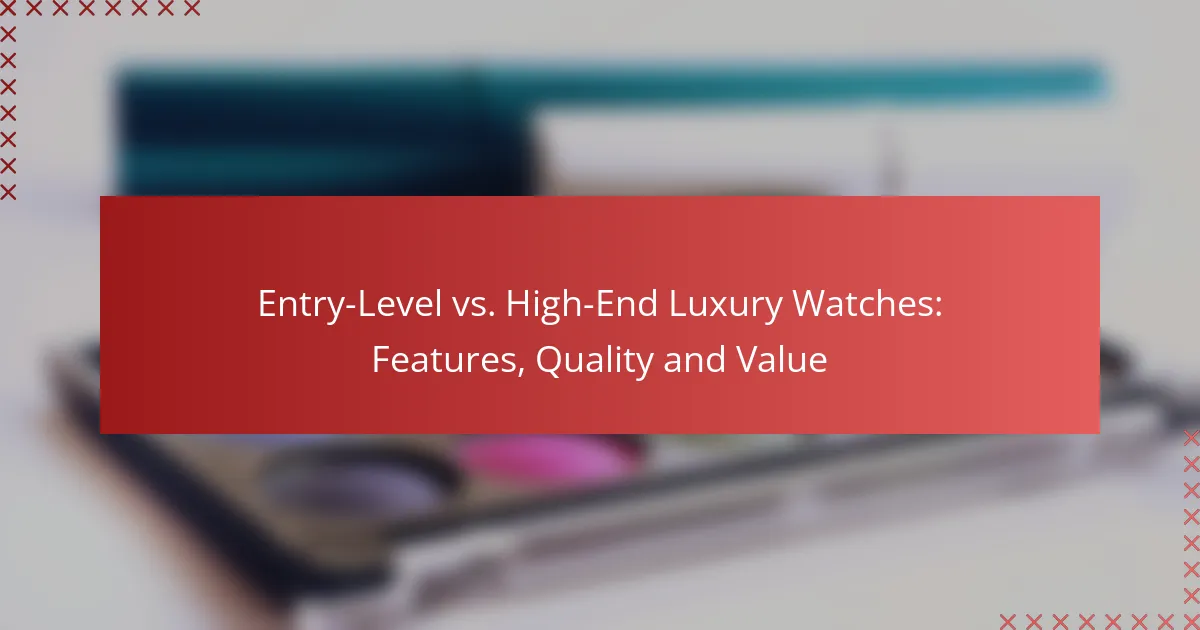When exploring the world of watches, it’s essential to understand the distinctions between entry-level and high-end luxury models. These differences encompass price, materials, craftsmanship, and brand reputation, all of which play a crucial role in a buyer’s decision-making process. By considering features like movement type, water resistance, and warranty options, consumers can better assess the performance and long-term value of their chosen timepiece.

What are the key differences between entry-level and high-end luxury watches?
Entry-level and high-end luxury watches differ significantly in price, materials, craftsmanship, and brand reputation. Understanding these differences can help buyers make informed decisions based on their preferences and budget.
Price range comparison
Entry-level luxury watches typically range from a few hundred to a few thousand dollars, making them accessible to a broader audience. In contrast, high-end luxury watches often start at several thousand dollars and can exceed tens of thousands, depending on the brand and features.
For example, a reputable entry-level brand may offer models priced between $300 and $1,500, while high-end brands like Rolex or Patek Philippe can command prices from $5,000 to well over $100,000. The investment in a high-end watch often reflects its exclusivity and craftsmanship.
Quality of materials
Entry-level watches often use stainless steel, mineral glass, and synthetic materials, which are durable but may lack the luxury feel. High-end luxury watches, however, utilize premium materials such as 18k gold, sapphire crystal, and high-grade leather, enhancing both aesthetics and longevity.
For instance, while an entry-level watch might feature a basic quartz movement, a high-end luxury watch may incorporate a complex mechanical movement crafted from high-quality metals, contributing to its overall value and performance.
Craftsmanship standards
Craftsmanship in entry-level watches is typically mass-produced, focusing on efficiency and cost-effectiveness. High-end luxury watches, on the other hand, often involve meticulous handcrafting, with skilled artisans dedicating hours to ensure precision and quality.
This attention to detail can include intricate complications, such as tourbillons or perpetual calendars, which are rarely found in entry-level models. The craftsmanship not only enhances functionality but also elevates the watch to a work of art.
Brand reputation
Brand reputation plays a crucial role in the luxury watch market. Entry-level luxury brands may have a solid reputation for quality but often lack the historical prestige associated with high-end brands. High-end luxury watchmakers, like Audemars Piguet or Omega, have established legacies that contribute to their desirability and perceived value.
Consumers often associate high-end brands with exclusivity and status, which can significantly influence resale value. A well-known luxury watch can retain its value or even appreciate over time, while entry-level watches may depreciate more quickly.

What features should I consider when choosing a watch?
When selecting a watch, consider features such as movement type, water resistance, and warranty and service options. These aspects significantly influence the watch’s performance, durability, and long-term value.
Movement type
The movement type refers to the mechanism that powers the watch. Common types include quartz, which is battery-operated and known for accuracy, and mechanical, which can be either manual or automatic, relying on intricate gears and springs.
Quartz watches are generally more affordable and require less maintenance, while mechanical watches often appeal to collectors due to their craftsmanship and heritage. When choosing, consider your lifestyle and how much you value precision versus tradition.
Water resistance
Water resistance indicates how well a watch can withstand exposure to water. Ratings typically range from 30 meters, suitable for light splashes, to over 300 meters, which is ideal for diving.
For everyday wear, a watch with at least 50 meters of water resistance is advisable. If you plan to swim or dive, look for higher ratings. Always check the manufacturer’s specifications, as water resistance can diminish over time.
Warranty and service
A watch’s warranty and service options are crucial for long-term ownership. Entry-level watches may offer limited warranties, while high-end luxury brands often provide extensive coverage and service plans.
Consider the duration and terms of the warranty, as well as the availability of service centers. A good warranty can save you money on repairs, while a reputable service network ensures your watch remains in top condition for years to come.

How do entry-level watches perform in terms of quality?
Entry-level watches typically offer good quality for their price, often balancing functionality and style without the high costs associated with luxury brands. While they may lack some advanced features and premium materials, many entry-level models are reliable and well-constructed, making them suitable for everyday wear.
Durability and reliability
Entry-level watches are generally designed to withstand daily use, featuring materials like stainless steel and mineral glass that provide decent durability. Many models are water-resistant to varying degrees, often rated between 30 to 100 meters, which is adequate for everyday activities but not suitable for diving.
Reliability is another strong point, with many entry-level watches utilizing quartz movements that require less maintenance and offer accurate timekeeping. However, mechanical options are available, though they may need more care to ensure longevity.
Maintenance requirements
Maintenance for entry-level watches is typically minimal, especially for quartz models, which only require battery replacements every few years. Regular cleaning and occasional servicing can help maintain the watch’s appearance and functionality, but this is usually straightforward and cost-effective.
For mechanical watches, users should consider servicing every few years to keep the movement in good condition. This can range from $50 to $200 depending on the brand and complexity, making it a worthwhile investment for those who prefer the craftsmanship of mechanical timepieces.

What are the advantages of high-end luxury watches?
High-end luxury watches offer exceptional craftsmanship, unique features, and significant investment potential. These timepieces are often made with superior materials and intricate designs, making them not only functional but also status symbols.
Investment potential
High-end luxury watches can serve as valuable investments, often appreciating in value over time. Brands like Rolex, Patek Philippe, and Audemars Piguet have a history of retaining or increasing their worth, sometimes yielding returns of several tens of percent over a decade.
When considering a luxury watch as an investment, focus on limited editions or models with historical significance, as these tend to perform better in the resale market. Keep in mind that market trends can fluctuate, so thorough research is essential.
Exclusive features
Luxury watches often come equipped with exclusive features that enhance their appeal and functionality. These may include intricate complications like perpetual calendars, tourbillons, and chronographs, which showcase the watchmaker’s skill and innovation.
Additionally, high-end models frequently utilize premium materials such as sapphire crystal, precious metals, and high-grade leather, contributing to their durability and aesthetic appeal. Such features not only elevate the watch’s status but also justify the higher price point.
Resale value
The resale value of high-end luxury watches is generally higher than that of entry-level models. Many luxury timepieces can be resold for a significant portion of their original price, especially if they are well-maintained and come with original packaging and documentation.
To maximize resale value, consider purchasing models that are in high demand or have a strong collector following. Regular maintenance and proper storage can also help preserve the watch’s condition, ensuring it retains its value over time.

How do I determine the value of a luxury watch?
To determine the value of a luxury watch, consider factors such as market demand, condition, and provenance. These elements significantly influence both resale value and collector interest.
Market demand analysis
Market demand analysis involves evaluating how popular a specific watch model is among collectors and enthusiasts. High demand can drive prices up, while lesser-known models may not retain value as well. Research recent sales, auction results, and online marketplaces to gauge current trends.
For example, iconic brands like Rolex or Patek Philippe often see strong demand, while niche brands may fluctuate. Keeping an eye on social media and watch forums can provide insights into which models are gaining traction.
Condition and provenance
The condition of a luxury watch is crucial in assessing its value. Watches in excellent condition with original parts, minimal wear, and proper servicing records typically command higher prices. Conversely, watches with significant damage or aftermarket modifications may see a substantial drop in value.
Provenance, or the watch’s history, also plays a key role. A watch with a notable previous owner or a unique story can enhance its desirability. Documentation such as original receipts, service records, and box or papers can further substantiate its value.
